#prairie dropseed
Explore tagged Tumblr posts
Text

Field at Dusk, Pennsylvania - September 14th 2024
#nature#photographers on tumblr#dusk#grasses#not hay its prairie dropseed mostly#original photography#pennsylvania#early autumn
10 notes
·
View notes
Text
work has not been as fulfilling as I wanted it to be but I did just submit my first landscaping plan for a pollinator garden at my employers city hall so!!! very cool!!!
#not chic/ago. just the city I work for#I couldn’t do pink muhly as my grass though bc the supplier was put 😫😫 prairie dropseed it is#double shot
15 notes
·
View notes
Photo

Front Yard Natural Stone Pavers Detroit Design ideas for a small asian partial sun front yard stone water fountain landscape in summer.
#landscape designer#entry pergola#'stone forest' granite water fountain#landscape installation#bluestone steppers#prairie dropseed ornamental grass
0 notes
Text
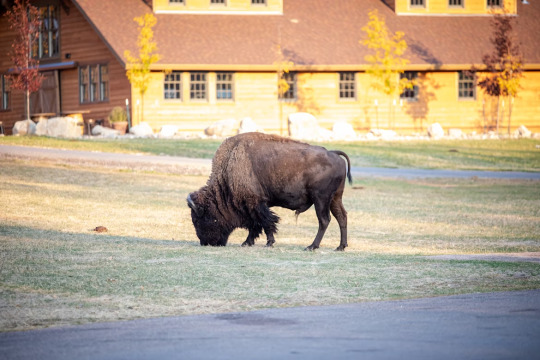
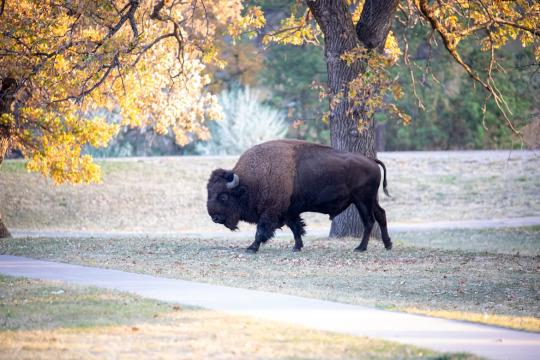
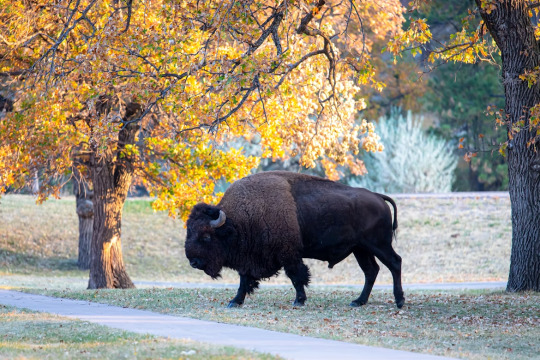
Plains Bison in Custer, South Dakota, USA
Stephanie LeBlanc
The Plains bison is one of two subspecies/ecotypes of the American bison, the other being the wood bison.
Status: Near Threatened
Population: 45,000
Scientific Name: Bison bison bison
Kingdom: Animalia
Phylum: Chordata
Subphylum: Vertebrata
Class: Mammalia
Order: Artiodactyla
Family: Bovidae
Subfmaily: Bovinae
Tribe: Bovini
Genus: Bison
Weight: 701 to 2,000 pounds
Length: 7-12 ft.
Habitat: Grassland
Range: Bison once roamed from Florida to Washington, Canada, and Mexico - The entire U.S.
Predators: Wolves are the primary predator of bison across the continent. Local knowledge also indicates that bears play a role in predation.
Diet: Bison are considered generalist foragers, meaning they eat a wide array of herbaceous grasses and sedges commonly found in mixed-grassed prairies. These types of plants include species such as Blue gramma, sand dropseed, and little bluestem.
Lifespan: The average lifespan for a bison is 10–20 years, but some live to be older. Cows begin breeding at the age of two and only have one baby at a time. For males, the prime breeding age is six to 10 years.
Importance: Bison graze the grasses at different heights, providing nesting grounds for birds. They also roll around and pack down the soil in depressions in the ground known as wallows. Their wallows fill with rainwater and offer breeding pools for amphibians and sources of drinking water for wildlife across the landscape.
#Custer#South Dakota#USA#Plains Bison#Bison#Wildlife#SDWildlife#US#United States#United States of America#North America
37 notes
·
View notes
Text
national poetry month, day 27
let grow more winter fat / wine-cup / western wild rose so little open prairie left little waves of bluestem little
fuzzy tongue penstemon quieter the golden currant
nodding onion quieter now as well only a few clusters of Colorado butterfly plant still yawn into the night where there once was prairie
a few remaining fireflies abstract themselves
over roads and concrete paths prairie wants to stretch full out again and sigh— purple prairie clover prairie zinnia
prairie dropseed nodding into solidago
bee balm brushing rabbitbrush—prairie wants prairie wants
prairie wants —Camille T. Dungy
#camille t. dungy#let grow more winter fat / wine-cup / western wild rose#poetry#national poetry month#npm2025
2 notes
·
View notes
Text

Surveying a high quality mesic blacksoil prairie

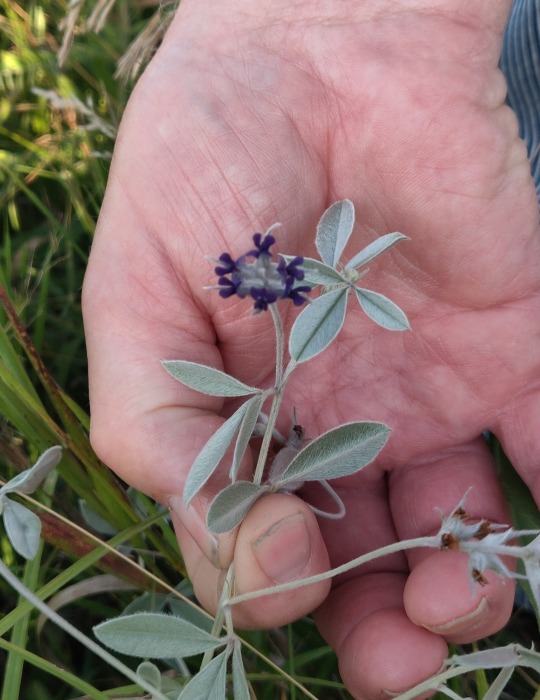

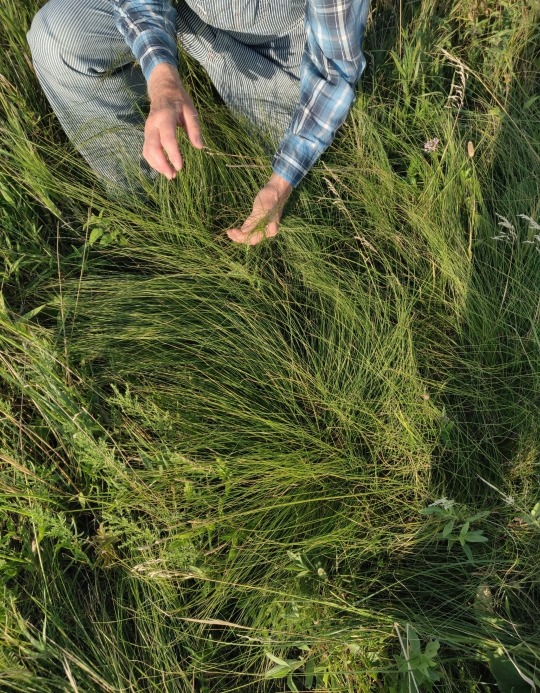

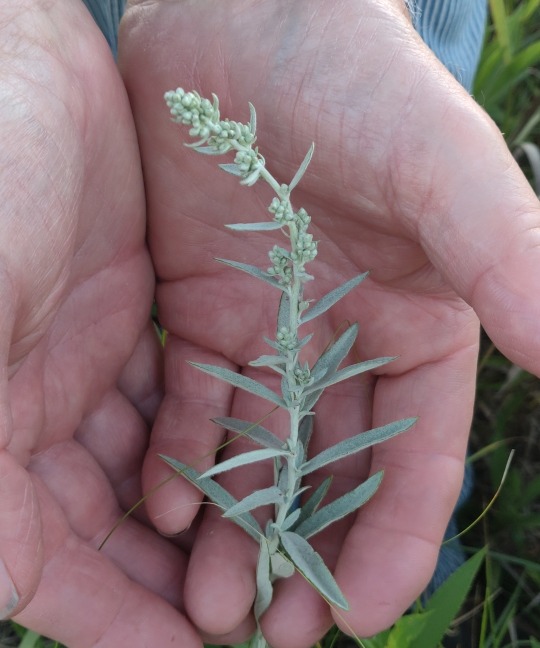
1. Blue vervain
2. Silvery scurfpea
3. Prairie phlox
4. Prairie dropseed
5. Rough blazing star
6. Silver wormwood
#prairie#prairies#nature#naturalist#north america#nature photography#photography#midwest#flowers#water#grasses#grass#flower#wildflower#wildflowers#ecology#mine#biology#botany#ecologist#natural resources
54 notes
·
View notes
Text
hieros gamos.
your touch, a charm your kiss, a trance green man that you are abundant, overflowing sprouting grasses, blooming, leaning in your tiger's eyes hold me close while you and I merge deeply. your sensitive skin inside me like silk magnetized and ravenous in awe and in love and even more than that gently spreading heart salves on unseen wounds you touch your tongue upon my skin (a sacrament like none before it) and split me open with such care I am opened to gaia I am opened to lilith I am opened up to sky and down to earth to cosmos and the underworlds to volcanoes and to rains to winds and oceans I am opened to artemis, persephone, and parvati I am between the worlds and rooted in you rooting through you over and around your stamen down through your blood, your bones your stones your water, your pollen, your nature and down into the earth herself I am rooted through you and elevated into the heavens I find myself the tree of life, of this realm and every next one my throat is open, that holy portal from voice to vulva I crest and break over you, over and again through you, and around you and the most primal divine light shoots from you, through me from tip to top up through sibling trees and out to stars down through soil and bedrock engulfing ancestors plunging straight to the core of the earth. in the service of aphrodite through soft skins on soft skins scar tissue is made and remade new again alchemy pouring through our pores exchanging molecules and magicks through our fields, our fluids, saliva, and our breath every part of me ever misused or abused, ignored or unseen, passed over for surface pleasures and cheap thrills - as you see me, worship me, pleasure me whole and drape me in the finest of green gowns ever known to the gods woven of bluebonnets and grama grasses firewheels and prairie dropseed you tuck a thistle behind my ear and flowercrown my stigma with sweet reverence and love you hold me up to gaia, selena, and great mother - in your arms, I am safe. in your heart, I am seen. together, we create new worlds and sow new dreams.
#poetry#poem#original#creative writing#love#sacred#divine#pollination#hieros gamos#green man#gaia#beltane#healing
3 notes
·
View notes
Text
My Garden Flowers Part 5
All photos mine. The blue flax is edited for colour since the camera didn't catch it and washed it out. The curlytop smartweed is edited for contrast and the scarlet bee balm is edited for colour since that phone camera sucked.
























In order of appearance:
121. Whorled Milkweed (Asclepias verticillata) Flowering for the first time this year! I hope she gets pollinated.
122. Blue Flax (Linum lewisii) Finally got this thing to flower. She doesn't live very long and my first two attempts grew just fine but didn't flower and therefore didn't reseed. Here's hoping this one does.
123. Lakeside Daisy (Tetraneuris herbacea) Not pictured as she hasn't flowered yet.
124. Fringed Sagebrush (Artemisia frigida) Took me several tries, including the wrong species sent, before I got one to take off but she survived the winter and is doing nicely this summer!
125. Black-Eyed Susan (Rudbeckia hirta) Sadly she didn't make it through the winter and I'll have to try another area, but she certainly looked nice while she was here.
126. Gray-Headed Coneflower (Ratibida pinnata) Flowering for the first time this year! Also my first successful attempt as BOTH my previous plants were cut where I had them. Two in a fucking row. She doesn't even look that weedy. I don't know what the fuck.
127. Narrow-Leaved Vervain (Verbena simplex) Sadly she didn't survive the winter. Trying her in another place and she seems to like it so far.
128. Pink Evening Primrose (Oenothera speciosa) Well, she certainly understood the assignment to prettify that area, though I had no idea she'd spread so much. My other Oenothera species are much more well-behaved. lol
129. Streamside Fleabane (Erigeron glabellus pubescens) Lovely little thing in the small spot I have her in. An ideal small space plant.
130. Green Comet (Asclepias viridiflora) Now she flowered last year but didn't make pods in spite of all the ants who came to visit. Hoping she'll make pods this year!
131. Spike Goldenrod (Solidago simplex) She looked nice here but didn't survive the winter. I'm trying one in another spot.
132. Prairie Dropseed (Sporobolus heterolepis) Not pictured as I haven't got any pictures yet.
133. Blue Leadplant (Amorpha canescens) Not pictured as she hasn't flowered yet.
134. Clammy Groundcherry (Physalis heterophylla) She also spread much more than I expected, but I don't mind. Potentially lots of ground cherries!
135. White Meadowsweet (Spiraea alba) A bit leggy as a bush, though that might be due to where I have her, but the flowers are yet again white and lacy and loved by pollinators.
136. Curlytop Smartweed (Persicaria lapathifolia) I didn't plant that, and wish I had gotten a better photo of her because she sadly never reseeded until this year, and her daughter is not quite as impressive as she was.
137. Slender Mountain Mint (Pycnanthemum tenuifolium) She is no longer with us as of this year and I'm not sure why. I've planted fireweed in that spot now and we'll see how she does. Maybe I'll plant slender mountain mint in the back instead.
138. Fireweed (Chamaenerion angustifolium) Not pictured as she hasn't flowered yet.
139 Michigan Lily (Lilium michiganense) Every year I end up with more! Springtime flower only and then she fruits.
140. Canada Columbine (Aquilegia canadensis) one of the relatively safe members of the buttercup family. You can pop a flower or two into your mouth for a refreshing sweet snack.
141. Prairie Smoke (Geum triflorum) Probably the most showy of her genus. Avens flowers tend to be small white or yellow on leggy stalks, but prairie smoke has red parts around white flowers that eventually become fluffy seedheads, hence the name. Plus the leaves turn red in the fall so very nice all around.
142. Golden Alexanders (Zizia aurea) She can get leggy in the summer, but the bright yellow flowerheads are nice in spring.
143. Canada Wild Rye (Elymus canadensis) She didn't make the winter. Again I think it was too dry. She may have reseeded, however, or else I've let a clump of crabgrass stay for far too long.
144. Purple Prairie Clover (Dalea purpurea) She's another one I had to get from a Manitoba company because no one in Ontario was selling this species (some do now though). She is thriving!
145. Wild Mint (Mentha arvensis) The area I have her in is fairly dry and blocked by sidewalk. She does occasionally get in the cracks but is otherwise well-behaved in her enclosure. The same cannot be said for the one I gave to my friend for her landlady's plant war. Apparently she's taken over the neighbourhood. Well done, native mint.
146. Scarlet Beebalm (Monarda didyma) She lived well for one year in that area and then never again. I'm trying her in a different spot where she hasn't flowered yet but seems to like it.
147. Purple Coneflower (Echinacea purpurea) That's a cultivar. I did eventually manage to get the wild type, but don't have a picture yet.
148. Canada Garlic (Allium canadense) In my humble opinion these are much tastier than ramps. They usually don't make flowers, opting to make bulbs instead, but this was a nice exception. They're springtime only, though.
149. Annual Fleabane (Erigeron annuus) I rescued her from a fallow area. Sadly she didn't reseed but I don't feel bad because that area is completely under development now and her offspring wouldn't have made it anyway. I gave her a chance.
150. Northern Bedstraw (Galium boreale) Not pictured as she hasn't flowered yet.
#blackswallowtailbutterfly#my photos#photography#my garden#garden flowers#native plant gardening#native flowers of Carolinian Canada and USA#Asclepias verticillata#Linum lewisii#Artemisia frigida#Rudbeckia hirta#Ratibida pinnata#Verbena simplex#Oenothera speciosa#Erigeron glabellus pubescens#Asclepias viridiflora#Solidago simplex#Physalis heterophylla#Spiraea alba#Persicaria lapathifolia#Pycnanthemum tenuifolium#Lilium michiganense#Aquilegia canadensis#Geum triflorum#Zizia aurea#Elymus canadensis#Dalea purpurea#Mentha arvensis#Monarda didyma#Echinacea purpurea
6 notes
·
View notes
Text
what do you know about pixie fountain tufted hairgrass
what do you know about raspberry wine scarlet bee balm
what do you know about summer storm hibiscus
what do you know about blue wonder cat mint
what do you know about prairie dropseed
what do you know about pink comet hibiscus
what do you know about pearl white bellflower
what do you know about little gold star black eyed susan
0 notes
Text
Happy 2025!
I love lists. Here’s the list of seeds I’m starting and plants I’m adding to the landscape this coming spring. My goal this year is to establish the perennial bones of the garden in the sun and partial sun areas of the property. 2026 will be dedicated to the shade and partial shade side.
Native Seeds
New England Aster- Symphyotrichum novae-angliae
Showy Goldenrod- Solidago speciosa
Sweet Goldenrod- Solidago odora
Spotted Bee Balm- Monarda punctata
Wild Bergamot- Monarda fistulosa
Black-eyed Susan- Rudbeckia hirta
Sweet Black-eyed Susan- Rudbeckia subtomentosa
Sundial Lupine- Lupinus perennis subsp. perennis
Prairie Lily- Lilium philadelphicum
Northern Blazing Star- Liatris scariosa var. nieuwlandii
Downy Wood Mint- Blephilia ciliata
Butterfly Weed- Asclepias tuberosa
Common Milkweed- Asclepias syriaca
Tall Thimbleweed- Anemone virginiana
Anise Hyssop- Agastache foeniculum
Pale Purple Coneflower- Echinacea pallida
Purple Coneflower- Echinacea purpurea
Wild Mint- Mentha arvensis
Sweet Joe Pye Weed- Eutrochium purpureum
Hoary Mountain Mint- Pycnanthemum incanum
Canada Wild Rye- Elymus canadensis
Prairie Brome- Bromus kalmii
Prairie Dropseed- Sporobolus heterolepis
Purple Love Grass- Eragrostis spectabilis
Little Bluestem- Schizachyrium scoparium
Native Perennial Bareroots
Wild Strawberry- Fragaria virginiana
Elderberry- Sambucus canadensis
American Hazelnut- Corylus americana
Beach Plum- Prunus maritima
American Plum- Prunus americana
Native-ish Perennial Plants
High bush Blueberry - Vaccinium corymbosum var. “Patriot” “Blueray” and “Northblue”
King of the North Grape- Vitis spp. (V. riparia × Concord-type)
Plants & Seeds still to buy
Rosa setigera and Sunflowers
#new year#spring 2025#native plants#land stewardship#seed starting#pollinators#my garden#food forest
0 notes
Text
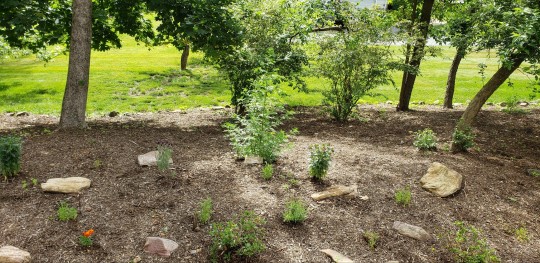

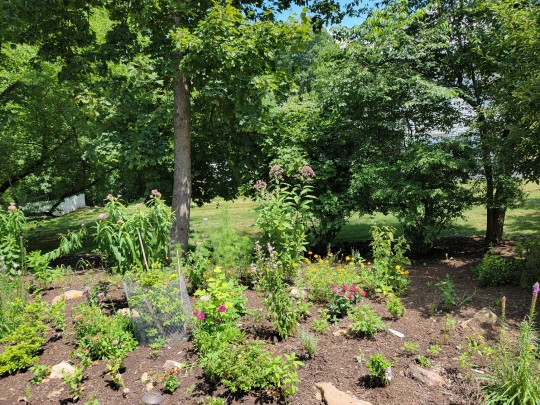

My Side Garden Over 4 Years
In 2019 the last of the 15 Ash Trees adjacent to my mother's home were taken out and I had decided to garden now that I had access to a yard again. The soil here is very rocky, prior to being constructed the side of this yard was a forest on the property line of a farm, that's why our ash were massive before they succumb to the borer.
The first year I planted some Perennials from a box-store and threw a random 'wildflower' seed mix in and unsurprisingly most of them died (although sweet-williams and cornflower persist which is fine with me)
The next year a whole bunch of annual cosmos and Zinnia took over but the only surviving perennials were native plants, after that I got more into native plants and got some native seeds from an adjacent field, Prairie Moon, and the forest that I spread. Then I got some native perennials from a local grower or took some divisions from my aunt (and grew some marigolds to keep the deer away).
The next year everything established and I did a layer of mulch over leaf litter to improve the soil a little, I discovered that in the coming drought this retained a decent amount of moisture for my young plants, I also noticed the diversity of insects and bird life that these plants brought. Our Yard was the only one with monarch caterpillars, constantly churning with butterflies, I noticed all new stingless bee species I'd never seen before, so many fascinating native fauna that never had decent habitat prior to this. I convinced the rest of my family to change their ways, less lawn, no pesticides at all, and less aggressive maintenance (I still weed but not as much because the perennials block out a lot of new growth). I noticed something else, fireflies I had grown up seeing were disappearing around the neighborhood, but not in this yard, because we had provided that proper leaf layer habitat for these fireflies, they were extremely abundant in our patch of garden. all the other neighbors who poison their gardens and heavily maintain lawns had nothing lighting up around them.
I'm studying in Landscape Architecture, work in architecture currently, my gardens look horrible because to me they are an opportunity to learn how plants grow. This year I made sure to keep leaf layer untouched in the hopes I could keep the fireflies, the garden looks really full even with little rain this may! it doesn't look perfect but the garden is more for ecosystem value (albeit rather small but to expand upon existing field nearby).
I try to plant things that I've seen growing wild locally, local natives in my garden as seen above include: Joe Pye Weed, Blueberry bush (highbush), Common Milkweed, Swamp Rose Milkweed, Butterfly Weed (ascelpias tuberosa), Columbines, White Snakeroot, spicebush, elderberry (this one is small in this garden), wild bergamot, various aster species, anise hyssop, and a tulip poplar sapling :)
Natives that are within this ecological region but not common to my area: blazing star, prairie blazing star, False Indigo, Blue flag Iris, Black eye'd Susan's, purple coneflower, obedient plant, Prairie dropseed, palm sedge, various sunflower species, bee balm, st. John's wort, whorled milkweed, various azaeleas, tickseed, eastern bluestar, Blue lobelia, and a persimmon tree
Nonnatives that do well and don't compete: English lavender, sweet Williams, 'Shasta' daisies, rocket larkspur, astilbes, cosmos (self seeding), tea rose, various herbs and annuals I throw in there like sunflowers, corn, amaranth.
17 notes
·
View notes
Text
3/11 update :-)
meadow blazing star
MO evening primrose
smooth hydrangea
hearts-a-bustin
joe-pye weed
showy sunflower
blue sage
obedient plant
pokeweed
dutchman's pipevine
southern blue flag
prairie dropseed
native seedlings started over winter: prairie sage, IL bundleflower, indiangrass, cup plant, yellow coneflower
veggie seedlings started this spring: snap peas, shelling peas, radishes, rat's tail radishes, cilantro, various mustard greens and brassicas, lettuce
plants that r awake in my garden as of now (keeping track for myself as spring goes on) :-)
anise hyssop
hairy mountain mint
purple coneflower
jacob's ladder
missouri gooseberry
swamp rose
coral honeysuckle
daisy fleabane
ohio spiderwort
bee balm
thyme
oregano
lemon balm
columbine
strawberries
goldenrod, aster, missouri coneflower, and foxglove beardtongue (retained green basal foliage thru the winter)
daffodils and hyacinths (planted by the previous tenant)
7 notes
·
View notes
Text
As illustrated in Figure 19.36, root system architecture varies widely among species, even those living in the same habitat.
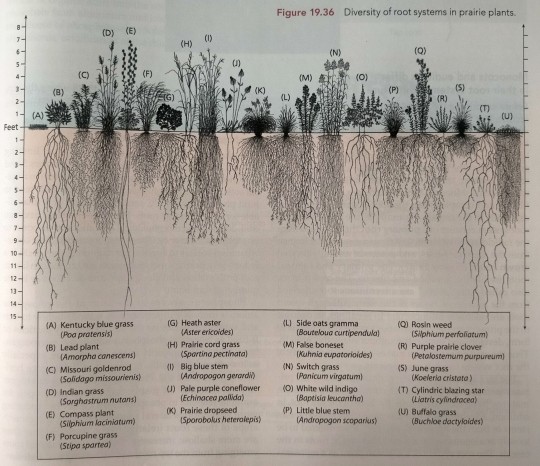
"Plant Physiology and Development" int'l 6e - Taiz, L., Zeiger, E., Møller, I.M., Murphy, A.
#book quote#plant physiology and development#nonfiction#textbook#root system#diversity#prairie#kentucky blue grass#lead plant#missouri goldenrod#indian grass#compass plant#porcupine grass#heath aster#prairie cord grass#big blue stem#pale purple coneflower#prairie dropseed#side oats gramma#false boneset#switch grass#white wild indigo#little blue stem#rosin weed#purple prairie clover#june grass#cylindric blazing star#buffalo grass#plant roots
2 notes
·
View notes
Text






Plains Bison in Custer, South Dakota, USA
Stephanie LeBlanc
The Plains bison is one of two subspecies/ecotypes of the American bison, the other being the wood bison.
Status: Near Threatened
Population: 45,000
Scientific Name: Bison bison bison
Kingdom: Animalia
Phylum: Chordata
Subphylum: Vertebrata
Class: Mammalia
Order: Artiodactyla
Family: Bovidae
Subfmaily: Bovinae
Tribe: Bovini
Genus: Bison
Weight: 701 to 2,000 pounds
Length: 7-12 ft.
Habitat: Grassland
Range: Bison once roamed from Florida to Washington, Canada, and Mexico - The entire U.S.
Predators: Wolves are the primary predator of bison across the continent. Local knowledge also indicates that bears play a role in predation.
Diet: Bison are considered generalist foragers, meaning they eat a wide array of herbaceous grasses and sedges commonly found in mixed-grassed prairies. These types of plants include species such as Blue gramma, sand dropseed, and little bluestem.
Lifespan: The average lifespan for a bison is 10–20 years, but some live to be older. Cows begin breeding at the age of two and only have one baby at a time. For males, the prime breeding age is six to 10 years.
Importance: Bison graze the grasses at different heights, providing nesting grounds for birds. They also roll around and pack down the soil in depressions in the ground known as wallows. Their wallows fill with rainwater and offer breeding pools for amphibians and sources of drinking water for wildlife across the landscape.
#Custer#South Dakota#USA#US#Bison#Wildlife#Plains Bison#SDWildlife#United States of America#United States#North America
8 notes
·
View notes
Text
Ornamental Grasses You Should Get to Know
Ornamental grass is beautiful, boisterous and bountiful. They're also easy to grow and pretty much deer- and drought-tolerant. Here are 10 you might want to try in your own yard.
— Luke MillerLuke Miller
Fountain Ornamental Grass

Fountain Ornamental Grass (Pennisetum Spp.) gets its name from the graceful, fountainlike foliage. The shape alone is enough reason to grow this beautiful grass. But then it's decorated by fuzzy flower plumes in late summer. In fall, the foliage turns buff, making it a nice contrast against darker plants like the kale in this photo. This is 'Hamlen' dwarf fountain grass, which reaches just 2-3 feet tall.
Prairie Dropseed

Prairie Dropseed (Sporobolus Heterolepis) is a handsome prairie ornamental grass with emerald green, hairlike foliage, and an arching shape. The foliage grows just 15-18 inches tall, with flower spikes reaching twice that height in late summer. Being tolerant of poor, dry soils, prairie dropseed is well suited for erosion control on slopes. It can also be used to replace lawn grass, needing less watering, fertilizing and mowing.
Karl Foerster Feather Reed Ornamental Grass

Karl Foerster's Feather Reed Ornamental Grass (Calamagrostis x Acutiflora 'Karl Foerster') has a rigid, upright shape. This grass punctuates the landscape, especially as the flower spikes begin to turn a rich golden color in fall. Foliage grows 18-24 inches tall, while the stalks (which make great cut flowers) can reach double that height. Feather reed grass accepts moist or dry soils.
Flame Grass

Flame Ornamental Grass (Miscanthus 'Purpurascens') is known for its brilliant reddish orange fall foliage. Which is punctuated by creamy white plumes. The medium green summer foliage takes on reddish hues as the season progresses, eventually reaching a height of 3-4 feet.
Porcupine Grass

Porcupine Ornamental Grass (Miscanthus Sinensis 'Strictus') and its cousin zebra grass (M. sinensis 'Zebrinus') are easy to spot in the garden. The bright green blades have golden bands, so they definitely stand out. While zebra grass has a relaxed habit, it grows up to 5 feet tall. And porcupine grass is more upright and can reach 8 feet in height.
Maiden Grass

Maiden Ornamental Grass (Miscanthus Sinensis 'Morning Light') is exquisite when backlit by, well, morning light. Or afternoon light. Or when sitting in the garden on a cloudy day. The arching foliage is decorated with narrow stripes of white, and reaches 4 to 5 feet. And this grass looks great all season. In late summer, dramatic plumes rise another foot, carrying the show through fall and winter.
Sedge

Sedge (Carex Spp.) is a brightly colored, small ornamental grass for borders and containers and looks particularly good when massed. The most common varieties found at garden centers have chartreuse, variegated or even tan foliage. The unique colors of the grasslike foliage are what really make sedge a popular garden plant.
Blue Fescue

Blue Fescue (Festuca Glauca) is a great ornamental grass to grow when space is tight. It's small and tidy—just 1 foot tall—so you can use it to edge the front of a flowerbed. Fortunately, the blue-gray foliage won't get lost among the greenery.
Purple Fountain Grass

Purple Fountain Grass (Pennisetum Setaceum 'Purpureum') is the ornamental grass for people who don't grow ornamental grass. Grown as an annual in most places, it is often used as a backdrop for annual flowerbeds and as a centerpiece in a container. The dark foliage and tan flowerheads are a sight to behold.
Pampas Grass

Dwarf Pampas Grass (Cortaderia Selloana 'Pumila') is highly recognizable. Due to the huge white feathery plumes that decorate the thick, blue-green foliage in late summer and fall. Although this pampas grass is a dwarf, it still reaches 5 feet tall, so place it in the back of a border.
— Luke Miller is an award-winning garden editor with 25 years' experience in horticultural communications, including editing a national magazine and creating print and online gardening content for a national retailer. He grew up across the street from a park arboretum and has a lifelong passion for gardening in general and trees in particular. In addition to his journalism degree, he has studied horticulture and is a Master Gardener. | FamilyHandyMan.Com
5 notes
·
View notes
Photo

By Tedd Hucks, done at Tedd2s, Peterborough. http://ttoo.co/p/24005
#hip tattoos#minimalist tattoo#nature tattoos#flower tattoos#prairie dropseed tattoos#medium size tattoos#teddhucks#small tattoos#tiny tattoos#little tattoos#tattoos#small tattoo#tiny tattoo#little tattoo#tattoo#ifttt
248 notes
·
View notes